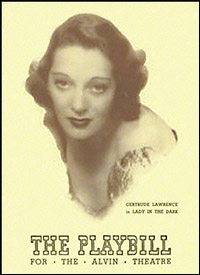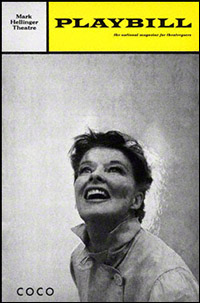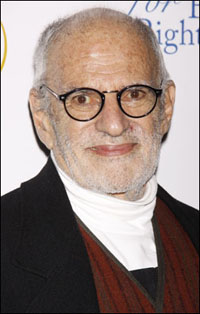
*
There is a long history of gays in theatre, going back to Shakespeare鈥檚 day, not to mention 鈥�. But when the story of the acceptance of gay lifestyles in Western civilization is told, live theatre in America will deserve a special place. Broadway has led the rest of the culture in its acceptance of gays and its early acceptance of the notion that gay romance was a story worth telling and exploring.
1895 Just days after the opening night of 鈥檚 masterpiece , the Marquis of Queensberry accuses the gay Irish playwright of homosexuality with the misspelled note 鈥淔or Oscar Wilde, posing somdomite鈥� [sic]. Wilde, who is secret lovers with Queensberry鈥檚 son, Lord Alfred 鈥淏osie鈥� Douglas, makes the mistake of suing Queensberry for libel, bringing the matter out in the open at the height of the Victorian era, when the subject has been considered unfit for public discussion. Wilde loses his suit, leading to his own arrest, conviction and imprisonment for the crime of sodomy. The disgrace means the end of his brilliant career, and his term in prison breaks his health. He dies in exile in Paris in 1900 at age 45. Wilde鈥檚 career and life serve as an inspiration, and a warning, and a point of outrage, to gays aspiring to the stage on both sides of the Atlantic. The subject is now 鈥渙ut鈥� and the genie can鈥檛 be put back into the bottle.
1896 New York is scandalized by A Florida Enchantment, a strange play about a magic seed that transforms people into the opposite sex. The story may seem laughably tame by today鈥檚 standards, but some audiences were deeply disturbed by the sight of a female actress taking on traditionally male characteristics and behavior, and a male actor gradually turning into what is supposed to be a woman, especially since the play brought up issues of lesbianism, male homosexuality and bisexuality in a relatively frank way. The play also contained the first recorded kiss between two women on the American stage, which reportedly caused fainting among both male and female members of the audience. Watch a clip of a 1914 short silent film adaptation of the play .
1904 The Broadway debut of female impersonator (1881-1941) in the musical comedy Mr. Wix of Wickham, one of the first of the so-called 鈥渘ance鈥� comics who were a staple in vaudeville to make it to the big time. Unlike his fellow female impersonator, the campy Bert Savoy, who would also later make it to Broadway, Eltinge strove to give the impression that he actually was a female, and the illusion was reportedly so convincing that he popularized the tradition of removing his wig at the conclusion of performances to show the audience he was really a man. He never married or maintained a relationship with a woman, and was widely believed to be gay, though he presented an exaggeratedly macho offstage persona and would fight anyone who suggested he was homosexual. He was so successful as a female impersonator that a Broadway theatre was named for him. The Eltinge Theatre still stands, having been converted to the AMC Empire 25 cineplex on West 42nd Street.
| |
 |
|
1923 Savoy is killed by a lightning bolt while walking by the sea in Long Beach, Long Island. His last words, upon hearing thunder, are reported as 鈥淎in鈥檛 Miss God cuttin鈥� up something awful?鈥�
1923 Determined to avoid another Florida Enchantment, cops shut down the Broadway transfer of a hit European play , which depicts a loving lesbian couple. The cast and producer are arrested on charges of "presenting an obscene, indecent, immoral and impure theatrical production.鈥�
1920s Greenwich Village becomes a mecca for gay women and men, many of whom contribute to the theatre life of the city. Satirical revues such as The Greenwich Village Follies and the Grand Street Follies showcase material much more daring than their uptown namesake.
1927 Mae West, a pioneer of frank sexuality on stage and off, follows up her scandalous 1926 hit play Sex with the gay-themed The Drag, her 鈥渃omedy-drama of life鈥� that she researched in the gay clubs of Greenwich Village. After the Society for Prevention of Vice threatened to have the play banned in New York, The Drag closes during its out-of-town tryout in Bridgeport, CT. 1927 Plays like 奥别蝉迟鈥檚 Sex and Eugene O鈥橬eill鈥檚 and others that push the boundaries of sexual and racial subject matter prompt the New York State Legislature to pass the so-called Wales Padlock Law, giving the district attorneys power to prosecute anyone associated with a play "depicting or dealing with the subject of sex degeneracy or sex perversion" and also giving them power to shut down theatres showing such plays. The law was rarely enforced but remained on the books into the 1950s. Gay-themed plays, including 1944鈥檚 Trio, were especially targeted.
| |
 |
|
1934 Previously the subject of derision and comedy, gay issues take a serious turn with 鈥檚 drama The Children鈥檚 Hour, which presents the story of a vengeful student who destroys the lives and careers of her school鈥檚 two headmistresses by publicly accusing them of being lesbians. The gay issue is soft-pedaled in the 1936 film version, 鈥淭hese Three.鈥�
1941 plays Russell Paxton, a character plainly intended to be gay, in the musical . From the 1930s to the 1960s (and beyond) plays use coded words (e.g. "sissy," "camp," for men; "tough," "butch" for women) and stereotyped behaviors to indicate characters are supposed to be gay, without saying so explicitly.
Early 1940s The hamlets of Cherry Grove and (later) Fire Island Pines on Fire Island become summer colonies for the better-off gays in the New York theatre world. Among the pioneers were writers and W. H. Auden, and their growing coterie often put on original shows and lampoons with references and humor that would not have been acceptable back in Manhattan.
1947 , a gay writer himself, authors , the portrait of a fading Southern Belle trying unsuccessfully to manage in the harsh modern world. Among her many regrets in life is the cruel way she treated her late husband Allan when she discovers him in a homosexual affair, which led to his suicide. In 1948 Streetcar becomes the first play with a gay theme to win the Pulitzer Prize for Drama. 1953 鈥檚 drama tells the story of a male private school student who is relentlessly bullied for being homosexual. Despite the broaching of the still- subject, the play ran 712 performances on Broadway. The story ends with the wife of one of the teachers trying an early version of conversion therapy, seducing the young man to help him feel macho. As she undresses, she delivers the memorable curtain line, 鈥淵ears from now, when you speak of this 鈥� and you will 鈥� be kind.鈥�
| |
 |
|
| Tennessee Williams |
1958 The plays of Oscar Wilde are among the inaugural offerings at Caffe Cino, a tiny restaurant/theatre that opens on Cornelia Street in Greenwich Village. Run by the eponymous Joe Cino, the theatre will, over the next decade, provide a greenhouse for talent that will come to flower on Broadway, including , , , , and Tom O鈥橦organ and will help spawn the Off-Off-Broadway theatre movement that will provide a podium for gay voices of all kinds. Among notable productions are Lanford Wilson鈥檚 1964 drama The Madness of Lady Bright, about a gay drag performer.
1960s During this decade the most daring expressions of gay theatre and the works of gay playwrights can be found Off-Broadway and Off-Off-Broadway with the works of writers as diverse as , Charles Ludlam and , some of them still working today.
1968 鈥� Oscar-winning script to the Broadway parody film "The Producers" features an outrageously camp portrait of a gay stage director called Roger DeBris, and his effeminate assistant Carmen Ghia.
1968 The best-known of the Off-Broadway boom in gay theatre is Mart Crowley鈥檚 The Boys in the Band, which begins a 1,000-performance run. A tapestry of a group of gay friends gathering for a party, it shows a spectrum of attitudes toward gay life, from self-loathing to defiant pride. Later filmed, the show is often credited as the first mass-culture depiction of queer society. Who鈥檚 to say what effect the play had on the participants in the next great revolutionary step in gay consciousness, which occurred just 14 months later? 1969 After enduring years of police harassment, patrons of the Greenwich Village gay bar Stonewall fight back in several nights of resistance that will come to be known as the Stonewall Riots, which mark the beginning of the militant phase of the gay civil rights movement. While not specifically theatrical, the riots grow out of the same Village cultural milieu as the plays of the recent years. Stonewall is located just steps away from Sheridan Square Theatre and just a few blocks from Caff茅 Cino.
| |
 |
|
1973 Oscar Wilde, and Alice B. Toklas are characters in Al Carmines鈥� Off-Broadway musical The Faggot, which runs six months.
1975 Terrence McNally鈥檚 , a farce set at a gay bathhouse, is a hit on Broadway. Among McNally鈥檚 numerous later plays and librettos include the gay-themed Love! Valour! Compassion!, which wins the Tony Award as Best Play, and , which wins the Tony as Best Musical.
1975 Also this year, happy gay couples are depicted in the Off-Broadway spoof musical Boy Meets Boy.
1975 Capping this busy year, , which shows gay characters working in musical theatre, wins both the Tony and the Pulitzer and goes on to become, for a time, the longest-running show in Broadway history. 1982 Former drag performer , whose autobiographical plays International Stud, Fugue in a Nursery and Widows and Children First! were performed separate Off-Off-Broadway at LaMaMa Experimental Theatre Club (and elsewhere), combines the three into a single evening titled , which begins a 1,222-peformance run on Broadway and wins the Tony Award. In the coming decades Fierstein will become a pioneer in the mainstreaming of gay life and drag performance through musicals like (1984) and (2013), written by himself, and (2002), written by others. Fierstein becomes a proudly out-of-the closet gay icon on Broadway and elsewhere.
1983 Fierstein, working with songwriter , adapts the French film La Cage aux Folles as a Broadway musical. For the first time a gay couple and gay romance are at the center of a Broadway musical. , who plays Albin, introduces the song 鈥淚 Am What I Am," which becomes an anthem of the movement.
| |
 |
|
| Photo by Joseph Marzullo/WENN |
1985 William M. Hoffman鈥檚 As Is becomes the first major play to deal with the AIDS epidemic, still in the early years of its terrible march on the gay community. It debuts Off-Broadway just a month before the better-known and subsequently moves to Broadway where it runs six months.
1985 Gay activist Larry Kramer chronicles the slow official response to the blossoming AIDS epidemic in his Off-Broadway play The Normal Heart, a scream of outrage not only against New York City health officials, but against fellow gay activists whom he felt didn鈥檛 demand action loudly enough.
1991 At the 1991 Tony Awards show actor is the first celebrity publicly to display the red AIDS ribbon, part of the Red Ribbon Project created by the New York-based Visual AIDS Artists Caucus which was trying to rally a public response to the growing health crisis. It is now an international symbol of AIDS awareness.
1992 's hit Off-Broadway musicals March of the and Falsettoland are combined into a single evening, titled Falsettos, which depict a man trying to juggle relationships with his ex-wife, his son, and his gay lover. Lesbian neighbors appear in the second half.
1993-94 finds supernatural significance in the AIDS epidemic with his epic Angels in America: A Gay Fantasia on National Themes, a drama about upheaval in heaven and on earth, presented in two parts, Millennium Approaches and Perestroika, both of which win the Tony Award as Best Play in successive years. Millennium Approaches also wins the Pulitzer Prize for Drama. The two plays are adapted as an Emmy-winning HBO miniseries.
| |
 |
|
| and in . | ||
| Photo by Paul Kolnik |
1998 cancels the planned opening of Terrence McNally鈥檚 Corpus Christi, a drama depicting Jesus and the apostles as homosexual, after members of the MTC board receive bomb threats. After an outcry over censorship, the production opens with peaceful protests but no violence.
2003 On this year鈥檚 Tony Awards broadcast, songwriters and , also partners in their offstage life, win the Tony for Best Score for their work on spray. In his acceptance speech, broadcast live on CBS in prime time, Shaiman turns to Wittman and says, "I love this man. We're not allowed to get married in this world... But I'd like to declare, in front of all these people, I love 'd like to live with you the rest of my life,鈥� followed by a kiss that scandalized some, and was cheered by many others.
2003 鈥檚 earns the Pulitzer Prize and Tony for Best Play for this portrait of a gay East German transvestite who survives both the Nazi and Communist regimes by posing as a woman. won the Tony for Best Actor in a Play for portraying 30 characters in the solo show.
2005 The Color Purple is the first major musical to depict a happy lesbian couple at the heart of its story. 2010 Ramin Setoodeh, an openly gay writer himself, pens an article in Newsweek criticizing the performances of in and in the TV series 鈥淕lee,鈥� saying that gay actors come off as 鈥渋nsincere鈥� when they try to play straight characters. Hayes鈥� co-star writes a response calling Setoodeh鈥檚 article 鈥渉omophobic鈥� and 鈥渂ullying.鈥�
2011 Broadway has become so linked with gays in the public mind that this year's Tony Awards broadcast opens with the tongue-in-cheek song "It's Not Just for Gays Anymore."
2011 The day gay marriage becomes legal in New York State, three same-sex couples wed on the stage of the Theatre, where Hair is playing: actress and jewelry designer Donna Barnett, actor and playwright Josh Levine, and stage doorman John Raymond Barker and usher Jared Pike.
2013 鈥檚 tells the story of a 1930s 鈥渘ance鈥� comedian who is gay in real life, whose career is collapsing at the end of the 鈥淧ansy Craze鈥� and of Burlesque. Both Lane and the play are nominated for Tony Awards.
2014 Fun Home, a musical based on 's 2006 graphic novel about a lesbian woman recalling her childhood and especially her closeted gay father, is named a finalist for the Pulitzer Prize.
2014 Terrence McNally鈥檚 鈥� his 20th Broadway show 鈥� offers the first depiction of married life among gays in a Broadway play.
2014 Harvey Fierstein鈥檚 drama tells the story of a real-life 1960s Catskills resort that catered to straight men who liked to dress as women鈥攁nd who do all they can to avoid being confused with gay men. Both Casa Valentina and Mothers and Sons are nominated for the Tony Award as Best Play.









